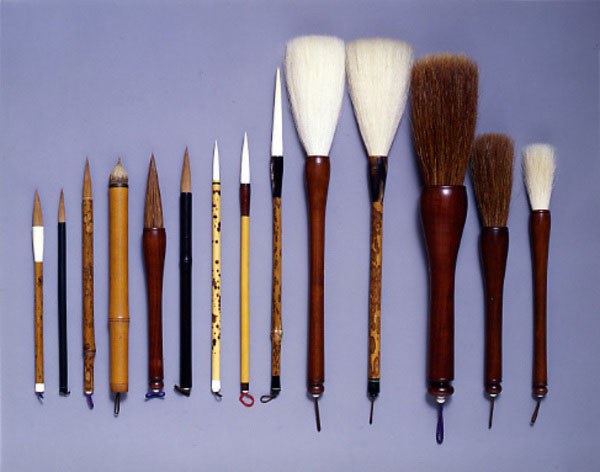
- Writing tools
- Aichi
Toyohashi brushes Toyohashi fude
High-quality craftsmanship and top-class brushes
Smooth touch and flow loved by professionals
Description
What is Toyohashi brushes ?
Toyohashi brushes are calligraphy brushes produced in the area around the city of Toyohashi, Aichi prefecture. They are known as high quality brushes and the favorite of many calligraphers. There are over a hundred types of brushes that are not only for calligraphy but also for makeup, Japanese painting, and traditional crafts. Toyohashi brushes have the second largest brush production in Japan after Kumano brushes, from the town of Kumano, Hiroshima prefecture. The overall annual production of Toyohashi brushes is 1.8 million brushes and its premium range accounts for seventy percent of the high-end market.
The brush has smooth writing strokes and easy ink absorption. Those characteristic features are the result of carefully blending of different hairs. The hairs are carefully assessed and sorted by their length, thickness, stiffness and elasticity. The sorted hairs are then soaked in water, combed, and mixed together well to ensure easy ink absorption.
History
In 1804, the lord of the Yoshida domain (now the city of Toyohashi) invited a brush maker from Kyoto to come and work for the domain administration. The domain was having financial difficulties and lower class samurai were making brushes for supplementary income.
Toyohashi is located in a mountainous region, making it relatively easy to secure the hair of Japanese raccoon dogs and weasels. In addition, it was one of fifty-three post towns (rest areas) of the Tokaido Highway*, helping spread the craft across the country.
In the early years of the Meiji period (1868-1912), Jirokichi HAGA promoted the production methods of a coreless brush called a suihitsu (current calligraphy brush). These new production methods, which are still in place today, improved upon the previous brushes that had wound paper in their core. His apprentice, Jusaku SANO, further improved the calligraphy brush and established a foundation for the current Toyohashi brush. The postwar baby boom and reintroduction of calligraphy to the school curriculum heralded the golden age of Toyohashi brushes. In 1976, Toyohashi brushes was registered as a traditional Japanese craft.
*The Tokaido Highway linked Kyoto to Edo (old name of Tokyo) during the feudal Edo period (1603-1868).
General Production Process
- 1. Selection
The quality and length of the hair is examined and classified by purpose. Then, the hair is either boiled or soaked in lukewarm water with the temperature being adjusted based on hair type. The bundles of hair are then dried and a metal comb is run through to remove unnecessary hair.
- 2. Rolling the hair
Bundles of each type of selected hair are mixed with rice husk ashes and rolled in buckskin to remove the oil content, improving the ink absorption. Then, the hair tips are aligned and allocated to the tip, middle, or base section of the brush head.
- 3. Combing
The hair tips are aligned and the hair bundles are meticulously combed with a specialized metal comb to shape the brush head.
- 4. Blending the hair
Hair types from three different sections are soaked in water and evenly mixed. This process allows the creation of a flexible brush that easily soaks up ink. Brush makers are able to evenly mix and blend the core hair with no loss of hair because of their many years of experience.
- 5. Making the core
Low quality hair is removed from the bundle to ensure the brush tips will not split. Then, enough hair for the brush core is gathered, rounded, and inserted in a mold to form the shape. The finished core is dried and a thin outer layer of evenly combed fine quality hair is wrapped around the core to produce a brush with a smooth writing stroke.
- 6. Finishing touches
The brush head is hardened by soaking in glue and linen thread is wrapped around it. The base is firmly tightened to adjust the shape. Then, the completed brush head is inserted and glued in a bamboo holder and dried in the sun. Finally, the name of the artisan or product is engraved on the brush holder.
See more Writing tools
- Kumano brushes
- Ogatsu inkstone
- Akama inkstone
- Unshu abacus
- Banshu abacus
- Nara brushes
- Suzuka inksticks
- Toyohashi brushes
- Kawajiri brushes
- Nara Ink
See items made in Aichi
- Tokoname ware
- Akazu ware
- Toyohashi brushes
- Nagoya textiles
- Nagoya Buddhist altar
- Owari Cloisonné
- Arimatsu tie-dyeing
- Mikawa Buddhist altar
- Seto-sometsuke ware
- Nagoya kimono-dyeing
- Nagoya traditional paulownia chest
- Okazaki stonemasonry
- Nagoya Sekku Kazari
- Owari Buddhist altar equipment
- Sanshu Onigawara Crafts































































































































































































































































































